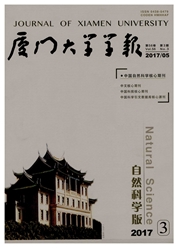

 中文摘要:
中文摘要:
探讨了显胎生红树植物木榄(Bruguiera gymnordhiza)、秋茄(Kandelia obovata)、隐胎生红树植物白骨壤(Avicennia marina)、桐花树(Aegiceras comiculatum)和非胎生红树植物木果楝(Xylocatpus grantum)的繁殖器官发育过程中铁(Fe)、钼(Mo)、锌(Zn)元素的含量变化.结果表明:在花蕾期,除白骨壤外,其他种类Fe元素含量相近,在0.0352—0.0454μg/mg之间.隐胎生红树植物白骨壤、桐花树中Fe元素含量在种子期最高,分别为0.0902和0.0733μg/mg,萌发后呈现降低的趋势,在胚轴成熟期达到最低.在种子期,Mo元素含量在胎生红树植物中差异不大,在0.2882~0.3020.g/mg之间,平均为0.2945ng/mg,明显高于非胎生红树植物木果楝0.1056ng/mg.种子萌发后,胎生红树植物中Mo元素含量下降.在同一时期,胎生红树植物种子的Mo元素含量明显大于木果楝.在木果楝的繁殖器官发育过程中,Zn元素含量逐渐下降,且比同期的胎生红树植物低.
 英文摘要:
英文摘要:
Changes of Fe, Mo and Zn dements were studied in the development of propagative organs from five mangrove species, inducling two viviparous species Bruguiera gymnanihiza and Kandelia obouata, two cryptovivipary species Auicennia marina and Aegiceras comiculatum and one non-viviparous species Xylocarpus grantum. In flower phase, mangrove phnts had similar Fe element content with 0.035 2 - 0.045 4 mg except Avicennia marina. Avicennia marina and Aegiceras corniculatura had highest Fe contents in seed phase with 0.090 2 and 0. 073 3 μg/ mg, respectively, then decreased after germination, and reached lowest in adult hypocotyl phase. In seed phase, four viviparous mangrove spedes had similar Mo element content with 0. 288 2 - 0.302 0 ng/mg, further more than non-viviparous X. grantura with 0. 105 6 ng/mg. After germination, viviparous mangrove species decreased Mo content. At same phase, X. grantum had lowest Mo content. In the development of propagative organs, X. grantum gradually decreased Zn element content, but was always lower than viviparous mangrove species at same phase.
 同期刊论文项目
同期刊论文项目
 同项目期刊论文
同项目期刊论文
 期刊信息
期刊信息
